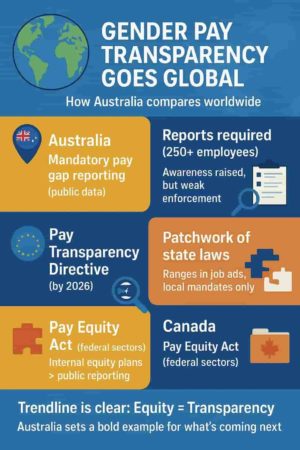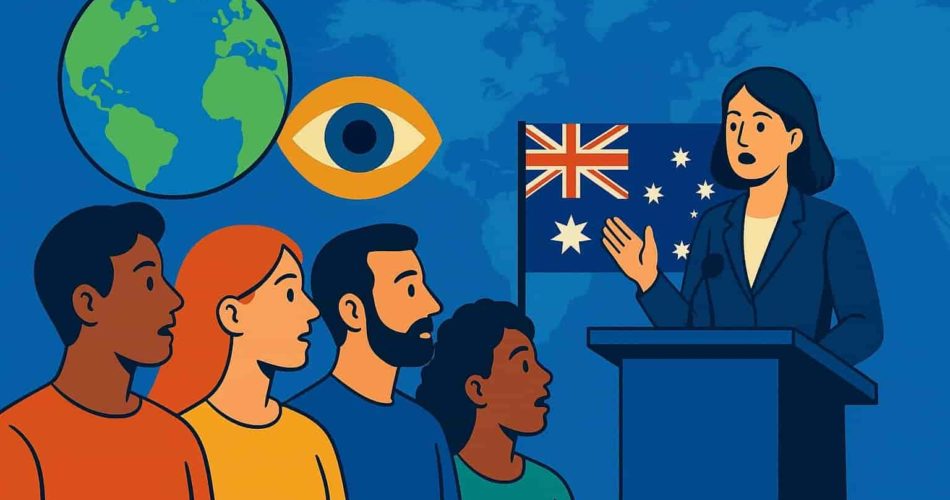In 2024, Australia took a bold step: it made gender pay gap data public for thousands of employers. Under new requirements from the Workplace Gender Equality Agency (WGEA), organizations with 100 or more employees must now report and disclose their median gender pay gaps. The results? Eye-opening. Some companies were celebrated for leading on equity, while others faced tough questions—and public scrutiny.
But this isn’t just a local issue. For HR leaders, workforce managers, and executives around the world, Australia’s move is a moment worth paying attention to. It’s a case study in how transparency, paired with accountability, can kickstart overdue conversations and push companies toward genuine change.
Whether your business operates in Sydney, Seattle, or Sheffield, the underlying lesson is the same: what gets measured gets managed, and what gets disclosed drives reform.
This blog breaks down what WGEA is, what the reporting shows, and most importantly, what any organization can take away from it, even outside Australia.
What Is WGEA and Why Does It Exist
The Workplace Gender Equality Agency (WGEA) is an Australian government agency established in 2012 with a simple but powerful mandate: to promote and improve gender equality in Australian workplaces. It sits at the intersection of public policy, compliance, and workplace culture, providing data-driven insights that inform both national debate and organizational decision-making.
Historically, employers reported to WGEA confidentially, submitting workforce gender data annually. But in early 2024, that changed. For the first time, WGEA made employer-specific gender pay gap data publicly accessible. The rationale? Confidential reporting wasn’t moving the needle fast enough. Transparency, policymakers argued, would light a fire under organizations to take action—not just collect data.
Here’s what sets WGEA’s approach apart:
- It uses median pay gap as the headline number (not mean), giving a more accurate picture of structural inequality.
- It applies to private sector employers with 100+ employees, capturing a large share of the labor force.
- It complements, rather than replaces, existing internal HR metrics—meaning companies must still take action beyond reporting.
WGEA isn’t about naming and shaming. It’s about giving employers and employees alike the data they need to drive progress. For organizations in other countries, WGEA offers a roadmap: one that goes beyond compliance and leans into cultural transformation.
The Compliance Crunch: What WGEA Reporting Season Looks Like in Practice
Every year between April and May, Australian HR teams find themselves in the thick of one of the most demanding compliance cycles on the calendar. It’s not just another report—it’s WGEA reporting season, and for organizations with 100 or more employees, participation isn’t optional.
At its core, WGEA reporting requires employers to disclose a wide range of gender-related workplace data. This includes metrics like workforce composition, gender-based differences in base and total pay, as well as hiring, promotion, and parental leave policies. It’s a comprehensive look under the hood of organizational equity.
But this isn’t a one-and-done spreadsheet submission. Data must be meticulously gathered, categorized, reviewed, and signed off by a company’s chief executive. And now that the results are made public, the stakes have changed: companies aren’t just reporting to meet regulatory requirements – they’re reporting in the public eye.
The operational pressure is real. Especially for HR teams juggling disparate systems, outdated databases, or fragmented people analytics. What was once seen as a routine compliance task has now become a critical moment of accountability – for leadership, culture, and brand reputation.
Australia’s Transparency Model: Raising the Bar for Global Pay Equity
What makes Australia’s gender equity push different isn’t just that employers have to report—it’s that their data is published and accessible. WGEA now releases pay gap figures by employer, meaning the public can see exactly how companies stack up on gender equity. And that’s a game-changer.
Unlike other regions where participation may be optional or data is only reported in aggregate, Australia’s model insists on:
- Universal compliance for employers over a certain size
- Publicly viewable employer-specific data
- A cultural nudge toward fairness through visibility, not just regulation
This kind of radical transparency goes beyond legal pressure. It drives accountability across leadership teams, influences public perception, and forces organizations to address disparities they can no longer hide behind percentages or averages.
It’s a shift from intention to action – from saying the right thing to showing the numbers behind it. For other countries and companies watching from the sidelines, Australia’s model is a clear signal: the future of workplace equity is open, measurable, and hard to ignore.

Looking Beyond Borders: How Australia’s WGEA Stacks Up Globally
Australia might be leading the charge on public gender pay gap reporting, but it’s far from alone in trying to make workplace equity measurable. Around the world, countries are rolling out their own transparency rules, and while each has its own playbook, the trendline is unmistakable: equity reporting is becoming the norm, not the exception.
Let’s break down how WGEA compares with other global efforts:
United Kingdom
Since 2017, UK employers with 250 or more employees have been required to report their gender pay gaps. The system has raised awareness, but enforcement varies, and the lack of public consequences means some companies have treated it more as a formality than a catalyst for change. Unlike Australia, the UK’s approach hasn’t always resulted in strong accountability or action plans.
European Union
With the Pay Transparency Directive kicking in, EU member states are preparing for sweeping reforms by 2026. These include mandatory salary ranges in job ads, employee rights to request pay data, and full audits for companies with significant gender gaps. It’s ambitious—but still in rollout mode. Australia’s already-published pay gap data puts it a step ahead in visibility and urgency.
United States
While there’s no federal law on gender pay reporting, several U.S. states are passing their own transparency laws. States like California, New York, and Illinois now require salary ranges in job postings and encourage proactive equity checks. It’s a patchwork approach that reflects growing momentum—but without a unified national mandate, companies often wait until local law forces their hand.
Canada
Canada’s Pay Equity Act (effective August 31, 2021) applies to federally regulated employers with 10 or more employees. Instead of focusing on annual pay gap disclosures, it requires organizations to develop, post, and maintain a pay equity plan that identifies and addresses gender-based wage disparities. Employers must also establish a pay equity committee (for larger organizations) and update the plan every five years. While this approach promotes fairness, it emphasizes internal pay equity planning and public posting of plans rather than releasing detailed pay gap data to the public each year—unlike Australia’s WGEA model, which centers on regular, public-facing reporting.
Across all regions, one message is becoming clear: workplace equity is shifting from internal promise to external proof. Australia’s WGEA model isn’t perfect, but it raises the bar by making pay transparency unavoidable. For companies outside Australia, this isn’t just a news story, it’s a preview of where compliance and culture are headed next.
Bringing It Home: Equity Starts with Visibility, but It Doesn’t End There
Australia’s WGEA model reporting has sparked a global conversation—but the lesson isn’t just about compliance or government mandates. It’s about how organizations choose to show up when it comes to fairness, transparency, and accountability.
Whether or not your company is legally required to publish pay gap data, the expectation for visibility is already here. And with it comes an opportunity: to move beyond slogans, to face the numbers honestly, and to build a workplace where equity isn’t performative—it’s provable.
So don’t wait for a law to do what’s right. Start gathering your data. Share your progress, even if it’s imperfect. Make equity a living part of your company culture, not just an annual report.
Because the companies that lead on equity now? They’re not just ticking boxes. They’re building workplaces people want to stay in, grow in, and believe in.



